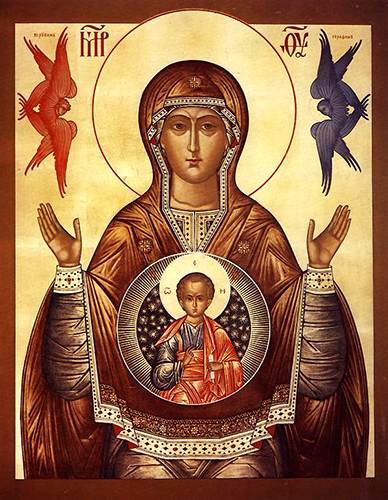The Paraklesis: Supplication Prayer to the Mother…
The Paraklesis: Supplication Prayer to the Mother of God
The Greek word Paraclesis Παράκλησις derives from παρακαλῶ.
It means to request, beg, or plead. It is to ask for help and solace.
Etymology:
From Koine Greek παρακαλῶ (parakalô, “invite”) contracted form of Ancient Greek παρακαλέω (parakaléō).
παρα- (para-) + καλώ (kaló, “call”).
The prefix παρα (up; beyond; beside; before)
The verb καλεώ: to call
To Thee O Virgin, Mother of God, we pour a flowing word, intercede for us.
Definition:
Paraklesis means comfort and supplication. This prayer is one of the most beautiful liturgical texts. It is a supplicatory prayer to the Most Holy Theotokos. This is not strange at all, for the Mother of God occupies a unique position in liturgical worship. Indeed, many praises and intercessions have been written for her. In the Orthodox Church, the month of August is consecrated to the Virgin Mary.
How nice it is to commemorate the words of Elizabeth inspired by the Holy Spirit to the Virgin Mary who was visiting her:
But why am I so favored, that the mother of my Lord should come to me? (Luke 1: 43)
It is even more beautiful to live and experience what Elizabeth said, and to be aware of this presence.

The Small and the Great Parclesis:
From August 1 to 14, the Orthodox Church chants the Small and Great Paraclesis alternately, in preparation for the feast of the Dormition of the Mother of God.
The small Paraklesis can also be chanted when one is sick or in distress.
It has also been the custom to be chanted in some monasteries and convents, after Vespers or during Small Compline, and on some feasts of saints. Many believers have it in their personal prayer rule.
History of the Paraklesis:
Researchers are confused about attributing the Small Paraklesis, is it to Monk Theosterictus the hermit or to saint Theophan. As for the Great Paraklesis, it is attributed to Emperor Theodore II Doukas Laskaris in the 13th century.
It has been the custom in early Christianity for the pious people of Constantinople to make processions in the streets of their City from August 1 to 14, holding the holy wood of the Cross, to consecrate the city and to preserve it from different diseases especially eye conjunctivitis which would rage against the citizens that month. The Patriarch and the believers would enter Agia Sophia, while chanting the Paraklesis with compunction and keeping the well-known fasting from August 1 – 14 every year.
The Book of the Paraklesis to the Theotokos:
There are different translations for the Greek text of the Paraclesis.
In 2004, when the present Patriarch John X was the Abbot of Balamand Monastery, a book was issued by the Balamand Monastery Publications. It contained the text of the service with a CD by the choir of the theological school at Balamand. The Arabic translation was made by Rev. Father Michel Saba according to the original Greek. The music was overhauled according to the Greek meters. It was written by His Eminence Ignatius Hoshee who was a brother at the school then.
